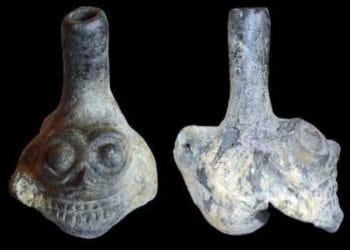A mysterious 6,500-year-old burial site in northern France may give clues about how women were viewed in that community during the Neolithic period.

The burial site is part of a series of long barrows, large earthen mounds, some extending hundreds of feet, that were occasionally enclosed by wooden palisades that have since decayed. In this study, researchers examined the DNA of 14 individuals from the Neolithic cemetery at Fleury-sur-Orne in Normandy, revealing a startling gender imbalance. Of the 14 individuals tested, only one was female.
What makes this discovery particularly intriguing is that the female in question was buried alongside “symbolically male” arrows, challenging traditional perceptions of gender roles. This led researchers to speculate that she may have been considered “symbolically male” to have been interred in the same grave.
The Neolithic barrows at Fleury-sur-Orne are attributed to the Cerny culture, which is found across several cemeteries in the Paris Basin region to the southeast. The Cerny culture is known for its burial practices, including interring individuals with arrows, quivers, and possibly bows, suggesting a connection to hunting.

However, the Fleury-sur-Orne cemetery differed significantly from its counterparts in the Paris Basin. While both men and women were buried in nearly equal numbers in the Paris Basin cemeteries, the cemetery at Fleury-sur-Orne was predominantly male.
The presence of a female in one of the barrows was an unexpected and intriguing find. Archaeologist Alison Burns, part of the research team, noted that it’s difficult to ascertain the exact status and role of this woman. “I don’t think we can speculate anyhow about her status — we don’t have enough elements for that,” Burns commented.
To further unravel the mystery surrounding this ancient woman, ongoing scientific work, such as isotopic analysis that examines elemental variations in her remains, may offer details about her diet and geographical origins.
The Neolithic cemetery at Fleury-sur-Orne, near Caen, was discovered in aerial photographs taken in the 1960s. Since 2014, the French National Institute for Preventive Archaeological Research (Inrap) has led a comprehensive excavation of the site. These excavations have unveiled an extensive 60-acre area with numerous Neolithic barrow graves and other monuments, including Europe’s longest barrow, measuring an impressive 1,220 feet (372 meters).
The research team analyzed the ancient DNA of human remains from the barrows at Fleury-sur-Orne, revealing the gender distribution among the individuals. Notably, they discovered that almost all of the individuals buried in the barrows were unrelated, except for a father and son buried in the same grave. This finding indicates that the Fleury-sur-Orne burials followed a patrilineal community structure where social authority was inherited through the male lineage. In such communities, daughters would typically leave to live with the families of their mates.
However, the presence of the female with arrowheads in the grave challenges the traditional interpretation of gender roles within the Cerny culture. While previous studies of Cerny cemeteries in the Paris Basin buried male individuals with arrows, suggesting a connection to hunting, the female buried at Fleury-sur-Orne was also interred with such symbolic artifacts.
The researchers postulated that these arrows were considered exclusively male in their associations within the Cerny culture, indicating that her burial in the monumental cemetery was essential. It appears that her gender was depicted as masculine, granting her access to this unique burial site.
Chris Fowler, a senior lecturer in later prehistoric archaeology at the University of Newcastle in the United Kingdom, who was not involved in the study, noted that the female buried at Fleury-sur-Orne was seemingly held in the same regard as the men interred there. He further pointed out that the barrow occupants from different lineages were unrelated, raising questions about the social and political dynamics within these communities.
This study opens a fascinating window into the dynamics of ancient societies and how they perceived and treated individuals with diverse gender roles. The presence of the female buried with symbolic arrows highlights the complexity of these Neolithic communities and the need for further research to gain deeper insights into their history.
— Live Science
More information: Rivollat, Maïté et.al. (2022), Ancient DNA gives new insights into a Norman Neolithic monumental cemetery dedicated to male elites. Proceedings of the National Academy of Sciences, 119 (18) e2120786119. doi:10.1073/pnas.2120786119































